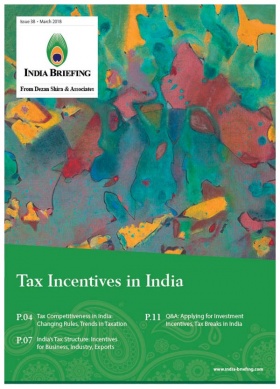India’s Mega Port Development Project ‘Sagarmala’: An Explainer for Investors
India has a 7,517 km (4,670.84 miles) long coastline, 14,500 km (9,010 miles) of potentially navigable waterways, and strategic locations along major international maritime trade routes.
Yet, the country has been unable to capitalize on its geography due to infrastructural and operational deficiencies.
Data shows that despite its long coastline, India’s coasts only contribute to 15 percent of national trade activity.
For instance, the turnaround time (TAT) at major Indian ports in 2014-15 was about four days; the global benchmark is an average of 1-2 days.
India highlights Sagarmala as China pushes Belt and Road Initiative
Targeting the above gaps in logistics connectivity infrastructure and efficiency, the government announced the Sagarmala project in 2015.
The initial blueprint is highly ambitious – setting up new ports, modernizing existing ports, developing coastal zones and boosting local employment generation, establishing connectivity between ports and road, rail, multi-modal logistics parks, pipelines, and waterways, as well as promoting coastal community development.
Such a comprehensive plan is now pitched as India’s primary infrastructure focus, rivaling China’s Belt and Road Initiative (BRI) that seeks to expand and build regional connectivity infrastructure. This includes building linkages between China and Eurasia, Southern China to Singapore, Bangladesh-China-India-Myanmar, and the China-Pakistan Economic Corridor that involves territory claimed by India as Pakistan-occupied Kashmir.
Addressing the third Indian Ocean Conference (during her official visit to Vietnam) organized by the Indian Ocean Rim Association (IORA) on August 28, India’s Minister for External Affairs Sushma Swaraj stated: “Under our Government’s ‘Sagarmala’ project, initiatives we have taken include building new ports and modernizing old ones, developing inland waterways, and hinterland development are all aimed at a robust maritime logistics infrastructure. Our eastern seaboard is a particular focus and can help recreate an integrated hub and spoke model for regional connectivity in the Bay of Bengal.”
Swaraj further emphasized that India’s regional infrastructure spending was guided by “interdependence rather than dominance or narrow reciprocal considerations” – a clear reference to some of China’s more controversial BRI plans.
What is Sagarmala?
Through its ambitious Sagarmala project, the Indian government wants to transform the country’s ports and reduce logistics costs for domestic as well as import/export cargo by optimizing infrastructure investment.
The government has planned six megaports under the project, namely the Vizhinjam International Seaport (Kerala state), Colachel Seaport (Tamil Nadu), Vadhavan Port (Maharashtra), Tadadi Port (Karnataka), Machilipatnam Port (Andhra Pradesh), and Sagar Island Port (West Bengal).
A study done in September 2016 estimates that the resultant cost savings could range from US$5.2 billion (Rs 35,000 crore) to US$5.9 billion (40,000) crore per year by 2025.
India currently permits 100 percent FDI for the construction and maintenance of ports.
The government also allows a tax holiday for 10 years and up to 50 percent financial aid – subject to a maximum of US$3.88 million (Rs 250 million) – for investing companies.
Under Sagarmala, 577 projects at an estimated investment of US$120 billion have been identified for phase-wise implementation over the period 2015 to 2035.
These projects will be taken up by the relevant federal ministries/agencies and state governments, preferably through private sector participation or public-private-partnerships (PPP). The details are as below:
- Port modernization – 245 projects (US$21 billion);
- Connectivity enhancement – 210 projects (US$36 billion);
- Port-linked industrialization – 57 projects (US$68 billion); and,
- Coastal community development – 65 projects (US$1 billion).
As of March 31, 2018, a total of 492 projects – worth US$62 billion – were under various stages of implementation, development, and completion.
Advantage of coastal shipping in India
Logistics in India contribute to 19 percent of the GDP, and remains among the highest in the world as compared to China’s 12.5 percent.
Several studies show that using coastal shipping and inland waterways would be 60 to 80 percent cheaper than road or rail transport.
If coastal shipping is used to complement road and rail transport in India, it could therefore lead to significant logistics cost savings. Additionally, the government recently relaxed transport rules for shipping, which will allow foreign ships to use coastal routes.
For example, in 2016, Korean automaker Hyundai Motors, followed by several other automobile manufacturers like Renault-Nissan, Ford, and Toyota shipped around 1,200 automobiles from Tamil Nadu to Gujarat. Car makers also reveal that the government has promised an 80 percent discount on ship cargo charges.
The Sagarmala project also aims to shift the movement of coal to the coastal route, which would cut down electricity costs by up to 35 percent. This is particularly true for coastal power plants in Andhra Pradesh and Karnataka, which receive coal by rail networks. Shipping of coal via ports can lead to estimated savings of about US$1.4 billion (Rs 10,000 crore) in the power sector.
This holds especially significant as the government passed the Coal Mines (Special Provisions) Bill, 2015 in March 2015 allowing for FDI in the sector. Coal can also be moved via shipping methods for non-electricity use, such as for use in steel plants.
Other products like steel, cement, fertilizers, and food grains will also be able to be shipped – at a capacity of around 80-85 million tons – by 2025.
The nitty-gritty of the Sagarmala project
The Sagarmala project focuses on three pillars as per the Indian government:
- Supporting and enabling port-led development through appropriate policy and institutional interventions and providing for an institutional framework for ensuring inter-agency and ministries/departments/states’ collaboration for integrated development.
- Port infrastructure enhancement, including modernization and setting up of new ports.
- Efficient evacuation to and from the hinterland.
Key initiatives under Sagarmala are:
- Port modernization and new port development;
- Port connectivity enhancement;
- Port-led industrialization; and,
- Coastal community development.
In addition, the government has also proposed 14 coastal economic zones (CEZs), which will link coastal districts to ports. Such CEZs are envisioned to be much bigger than India’s Special Economic Zones (SEZs), extending 500 kms (310 miles) along the coastline and 300 km (186 miles) inland. They will have coastal economic units for manufacturing facilities.
The CEZs are also expected to aid the planned industrial corridors, such as the Visakhapatnam-Chennai Industrial Corridor as well as the Delhi-Mumbai Industrial Corridor.
India’s respective states are expected to take the lead on developing CEZs, though experts feel that in order for CEZs to be successful, their actual implementation, tax structure, and incentives need to be emphasized.
Sagarmala project framework
The government formed the National Sagarmala Apex Committee (NSAC) to provide the overall policy guidance.
In addition, the government has incorporated the Sagarmala Development Company (SDC) under the Companies Act of 2013.
The SDC will help in project development and will serve as an agency for the coordination and monitoring of the Sagarmala project.
The SDC will also be responsible for raising funds in the form of debt or equity as per the project requirements.
To further support the project, the government has formed a Sagarmala Coordination and Steering Committee (SCSC) under the Cabinet Secretary along with other relevant ministries such as shipping, road transport and highways, tourism, defense, home affairs, and NITI Aayog to ease coordination between the different ministries and ensure efficient implementation.
Editor’s Note: This article was originally published in October 2016, and last updated in August 2018.
About Us
India Briefing is produced by Dezan Shira & Associates. The firm assists foreign investors throughout Asia and maintains offices in China, Hong Kong, Indonesia, Singapore, Vietnam, and Russia.
Please contact india@dezshira.com or visit our website at www.dezshira.com.
- Previous Article Delhi, Tamil Nadu, Haryana Top Investment Destinations in India: NCAER Report 2018
- Next Article EAEU-India Free Trade Zone: Initial negotiations eye improved access to new markets













